4 July 2018 - THE AUSSIE KOALA
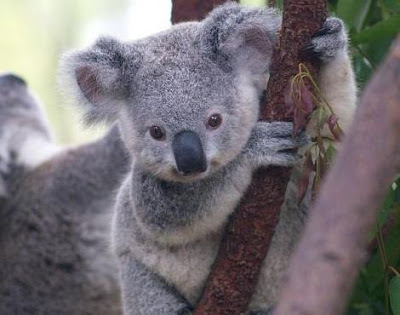
THE AUSSIE KOALA
G'day folks,
The Aussie koala is probably the creature most loved by tourists who visit Australia. Mind you, this continent, the driest on earth, is full of weird and wonderful creatures – and people!
Koala Classification and Evolution
The Koala is a small to medium sized mammalthat is found inhabiting a variety of different typesof forest in south-eastern Australia. Despite its appearance and the fact that it is also known as the Koala Bear, Koalas are in fact marsupials but are so distinctive amongst this specially adapted familyof mammalsthat they are classified in a scientific groupof their own. However, although they are now considered to be one of Australia's most iconic mammalspecieswhen European settlers first arrived things were very different, with millions of Koalas known to have been killed every year for their pelts (fur). The Koala is a unique animalthat famously feeds only the leaves of the eucalyptus trees which they inhabit but this dietis very hard to digest and lacks many of the vital nutrients that are key to the survival of a number of animalspecies. Today, although populations are stable and widespread the Koala is affected by habitatloss as vast areas of land are cleared every year to support growing development.
Koala Anatomyand Appearance
The Koala is one of the most charismatic of all marsupials with its large, wide face and round, white-tufted ears giving it the appearance of a small bear, along with their lack of a visible tail and smooth, black nose. The Koala has dense and soft grey or grey-brown fur which is lighter on their underside and mottled on the rear. Due to the fact that Koalas spend almost all of their lives in the trees, they have evolved a number of adaptations to help them with their arboreal lifestyleincluding having short, powerful limbs that are tipped with sharp claws. Having two opposablethumbs and three fingers on each hand means that Koalas are able to grip onto even the smoothest of bark when climbing and feeding in the trees. Koalas move about in the trees by jumping, first gripping the trunk with their front paws (helped by their rough paw pads and claws) before then moving both their back legs up the tree together, allowing them to get higher up.

Koala Distribution and Habitat
The Koala would have once been widespread throughout south-eastern Australiaand on a number of its surrounding islandsbut populations (particularly in the south) were wiped out in some areas due to hunting. They are however, surprisingly resilient and adaptable animalsthat are known to inhabit various typesof forest from the tall eucalyptus forests, to coastal regions and even low-lying woodlands further inland. Despite the fact that they are common in much of their natural range today, land clearance has not only meant a loss of their habitatsbut also separates populations from one another making them more and more isolated. It is not just loss of habitatto Humanactivity though that has led to population declines in certain areas, as quick-spreading forest fires can devastate vast areas of land in minutes and severely affect the local Koala populations in the process.
Koala Behaviourand Lifestyle
The Koala is a solitary and nocturnalanimalthat spends most of the daytime hours sleeping in the fork of a eucalyptus tree. Their low-energy diet(that is comprised only of the fibrous leaves of the eucalyptus) leads to Koalas leading a largely inactive lifestyleas they can happily spend up to 18 hours a day sleeping or simply just sit in the trees to conserve energy. Everything from sleeping to eating and even breeding is done in the trees as although Koalas are known to come down to the ground quite frequently, it is only so they are able to move to another tree. Koalas are also sedentaryanimalswhich means that they occupy a fixed home range which can vary in sizedepending on the abundance of food available (home ranges are smaller in areas with more food as there is no need to travel as far). Although the home ranges of males and females do overlap, males will not tolerate rival males intruding on their territoryand fight viciously by scratching and biting.
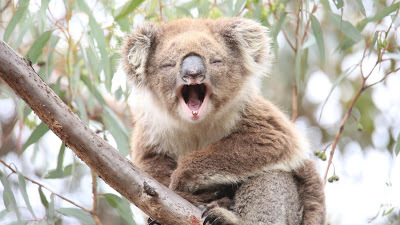
Koala Reproductionand Life Cycles
During the breeding season, males can be heard producing loud booming calls through the forest which are to both attract a female mate but also to deter any potential rivals. In Koala society it is the dominant male that gets to mate with the most females meaning that although males (like females) are able to reproduce from the age of two, breeding is not normally successful until the male Koala is between 4 and 5 years old and has established his dominance.
After a gestation period that lasts for a mere 35 days, a single joey is born that is about the sizeof a bee and very underdeveloped, and immediately crawls unaided into the pouch on its mother's belly. Here it attaches itself to one of the two teats and remains in the safety of the pouch until it is weaned at between 6 and 7 months old after having grown dramatically. The young Koala then clings onto its mother's back where it tends to remain for another few months or until the next season's young has developed and is ready to leave the pouch.
Koala Dietand Prey
The Koala is a herbivorous animalthat only feeds on the leaves of the eucalyptus (gum) tree in orderto survive. Despite there being around 600 different speciesof eucalyptus, Koalas only seem to feed on 30 of them which depends on the surrounding habitat. Eucalyptus leaves are tough and fibrous and often toxic making them inedible to other herbivorous animalsbut the Koala has evolved to fill this gap in the eco-system and has large cheek pouches where the leaves are stored. Once full, the Koala then begins to grind the leaves down into a pulp using their flat cheek teeth with some of the toxins then being detoxified by the liver. The Koala also has an incredibly long digestive tract to help it to break down the tough leaves which is more than three times its body length. In orderto help the process Koalas are also known to occasionally eat soil, bark and gravel to aid the digestion of such a fibrous plant.
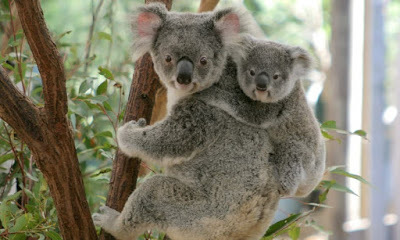
Koala Predatorsand Threats
Despite being relatively small, the lack of native mammalian predatorsin Australiameans that adult Koalas have very few natural predatorswith the exception of large Birdsof Prey. Young Koalas are more vulnerablehowever and are preyed on by a number of different animalsincluding Snakes, but both are most threatenedby domestic animalsparticularly dogsthat not only attack Koalas but are also known to spread disease into local populations. This is actually one of the biggest threats to Koalas in certain areas as large numbers of individuals have been affected particularly by the Chlamydia bacterium, which can actually be treated with antibiotics. Other threats to the current Koala populations include habitatloss to growing Humansettlements, tourist developments and forest fires that can spread rapidly in semiarid regions. The Koala populations on a number of islandshave also been affected by over-population as the increasing number of individuals means that there is less food to go around.
Koala Interesting Facts and Features
Due to the fact that Koalas sustain themselves on a dietthat is only comprised of leaves they have little need to drink as they get almost all of the water that they need through their food. However, living on a dietthat is so low in nutrients has led to the Koala evolving a very small brain for its body sizeas this organcan drain the body's energy supplies. After having spent their first six months of life developing in their mother's pouch suckling milk, baby Koalas must then attempt to eat solid foods with the first one being the soft droppings of their mother. Young Koalas are thought to do this as it contains a number of microbes that help the young to both fight off disease and to begin digesting the tough, fibrous leaves of the eucalyptus.
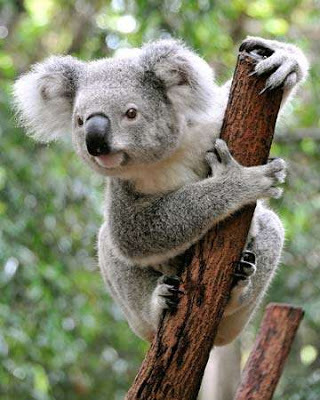
Koala Relationship with Humans
The Koala would have once been abundant throughout the forests of south-eastern Australiabut intense hunting of them for their soft fur in the early 20th Century led to drastic population declines and even local extinction in some areas. When the industry peaked in 1924 two million pelts were traded and eventually led to public outcry over the situation. Since then, the hunting of Koalas has been banned and management of populations has seen them increase once again. Despite their rising population numbers though, Koalas are affected by Humanactivity throughout much of their natural range mainly in the form of habitatloss as vast areas of land are cleared annually for development and agriculture. However, the Koala today is one of Australia's most famous and treasured speciesof mammaland is found on numerous emblems and in stories not just in Australiabut worldwide.
Koala Conservation Status and Life Today
Today, the Koala is listed by the IUCN as an animalthat is of Least Concern from becoming extinctin its natural environment in the near future. Population numbers are not just stable and widespread, but they are in fact too high in some areas with 10,000 individuals having been relocated back to mainland Australiaover the past 75 years to prevent islandpopulations from growing out of control. They are however, becoming more and more remote and isolated from one another which could cause problems in the future and are severely affected by introduced diseases in certain areas. Where possible though, infected Koalas (and particularly those that have been attacked by domestic dogs) are given veterinary first aid to try and help them in the future and prevent a large outbreak spreading through entire populations.

Clancy's comment: I've photographed many of these creatures over the years. Most of them have been found snoozing in a tree as seen below.
I'm ....
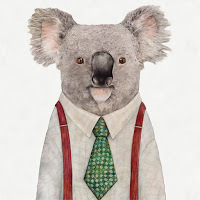


Published on July 03, 2018 14:26
No comments have been added yet.



